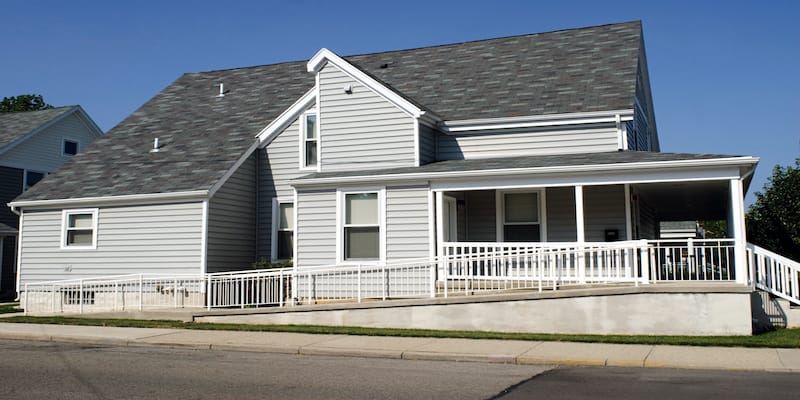There are times when disabilities can come in a blink of an eye, and just like that you need to make sure that every facet of your life is accessible.
Fortunately, you don’t have to build a custom home from scratch to make sure that it is accessible. Instead, you can upgrade your current home according to your specifications.
To make your home accessible, install a ramp, install a stairlift, make additional living space, use wood floors, use remote controls/apps, and rely on safety hoists. Regardless of your mobility issues, you can make just about any part of your home accessible, including the upper floors.
Here, we will show you how to create a handicap accessible home in greater detail. Let’s explore together.
Handicap Ramps
Many disabled people have trouble entering their homes if they have steps. However, you can add a ramp in front of any door. You have two options when it comes to handicap ramps:
- Portable Wheelchair Ramp: You can install a temporary ramp if you don’t have the budget to obtain a permanent one. Portable ramps are safe, but they should have such safety features as slip-resistant surfaces, drainage holes, and safety edges.
- Permanent Wheelchair Ramp: You can hire a contractor to build a permanent ramp extending over the steps. Wood is the most common material used when constructing a wheelchair ramp.
Also, you can install indoor wheelchair ramps. You can choose from several types of indoor ramps, including ones that accommodate complex rehab chairs.
When it comes to outdoor ramps, a permanent wheelchair ramp is the safest option. In general, the portable variety doesn’t have handrails.
Additionally, they’re not strong enough to support power chairs. One example of a temporary ramp is a track ramp. Track ramps can support conventional wheelchairs, but not scooters or power chairs.
With the permanent solution, you can tailor the ramp to your specifications. A contractor can add safety features and ensure the ramp can support your weight.
Stairlifts
If you live in a two-story home, install a stairlift to help you move between floors. Stairlifts come in different styles, and you can install them on most types of staircases. You can choose between a permanent stairlift or a temporary one.
A user can move from their wheelchair to the stairlift with ease. In particular, the comfort of a complex rehab chair allows you to move from the chair to the lift seamlessly.
After strapping yourself in, you’ll use a switch to move the lift to the upper or lower levels. With a stairlift, you don’t need other people to help you. Stairlifts also safe to use, and you can add additional safety features. Plus, they’re not as expensive as they seem.
Make More Room
You may have a tougher time getting around if you have a cluttered home. Moreover, furniture can be a barrier, especially as you make turns.
With that, you can space your furniture in a way that helps you navigate narrow walkways and sudden turns. Furthermore, remove as many items from the floor as possible to expand your mobility.
Above all, consider a complex rehab chair to maneuver around your expanded living space. Moreover, rehab chairs allow you to save money. For example, seat-elevation technology allows you to reach cabinets and surfaces easier.
Wood Floors
A wood floor can also help you maneuver throughout your living quarters. The solid surface of a wood floor will enhance your mobility. Wood also reduces the risk of slips and falls.
Carpets provide more resistance as you move about, and they trap more dirt and debris. The wheels on your chair will track dirt and debris from outside.
Overall, wood floors are easier to clean than carpets. When renovating the floors, keep two key things in mind:
- Remove all rugs from the home or place them in non-common areas
- Ensure that your bathroom floors are slip-resistant and have enough traction
If you currently have carpet in your home, you can hire a contractor to install wood floors. In addition, contractors can add traction to the floors and add slip-resistant applications.
Remote Controls
Almost everything in your home can be accessed with the sound of your voice or the touch of a button. With remote controls, you can control:
- Heating/cooling
- Appliances
- Lights
- Television
- Smartphones
- Blinds
You can also use apps to control your lights. With an iPhone or smartphone, for example, you’ll control LED lights and other electronics. Tablets perform the same tasks as well.
You can also use Siri to control lights, listen to music, among other tasks. The automation of mundane tasks will save time and requires less energy throughout the day.
Safety Hoists
In conjunction with complex rehab chairs, a hoist can lift you out of your chair safely and without assistance. Additionally, you can use a ceiling track, which is an overhead mechanism that moves you from one area to another using a railing system.
Hoists can help with shower chairs, toilets, and beds. More importantly, they will reduce the risk of injury exponentially.
Making Your Home Handicap Accessible
Making your home handicap accessible isn’t as arduous as you may think. You can install accessibility home modifications on a budget. For instance, apps and remote controls allow you to manage your home without moving around the house.
You can also add ramps inside or outside of your home. Additionally, you can replace carpets with wood floors for easier maneuverability. Also, you can use support mechanisms in the form of stairlifts and hoists.
Are you interested in learning how to shop for the best wheelchair? Click here to learn more.

